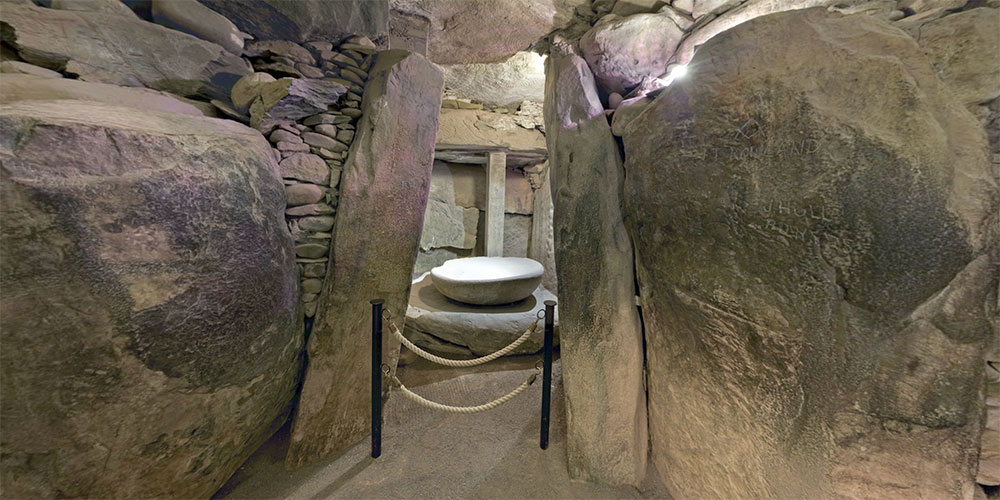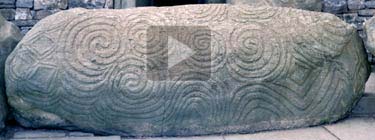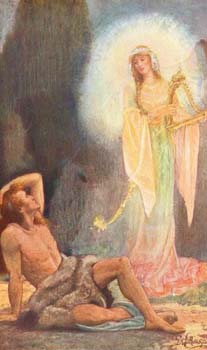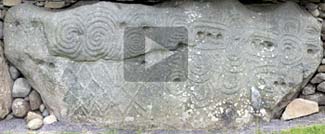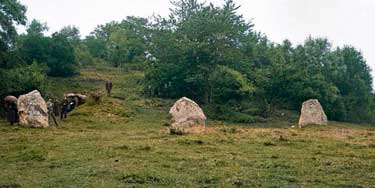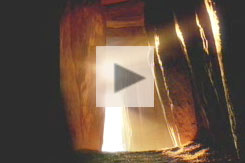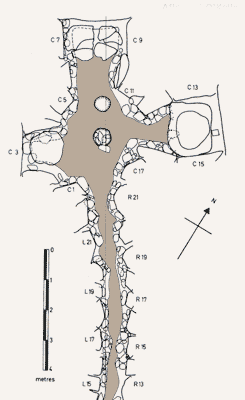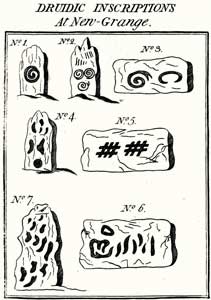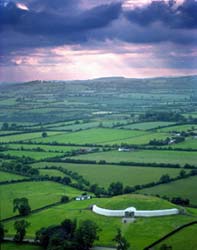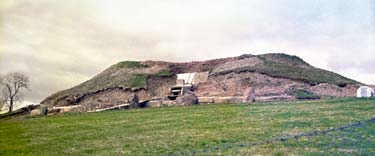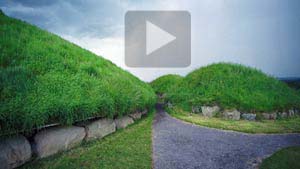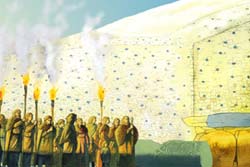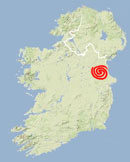21 Apr Newgrange
“As he spoke, he paused before a great mound grown over with trees, and around it silver clear in the moonlight were immense stones piled, the remains of an original circle, and there was a dark, low, narrow entrance leading within…
‘This was my palace. In days past many a one plucked here the purple flower of magic and the fruit of the tree of life…but look: you will see it is the palace of a god.’
And even as he spoke, a light began to glow and to pervade the cave, and to obliterate the stone walls and the antique hieroglyphics engraved thereon, and to melt the earthen floor into itself like a fiery sun suddenly uprisen within the world, and there was everywhere a wandering ecstasy of sound: Light and sound were one; light had a voice, and the music hung glittering in the air…
‘I am Aengus…men call me the Young. I am the sunlight in the heart, the moonlight in the mind; I am the light at the end of every dream, the voice for ever calling to come away; I am the desire beyond joy or tears. Come with me, come with me: I will make you immortal; for my palace opens into the Gardens of the Sun, and there are the fire-fountains which quench the heart’s desire in rapture.’”
Æ (George William Russell), “A Dream of Angus Oge,” 1897 1
Click the image above to enter the virtual-reality tour of Newgrange in a new browser window.
Double-click for the full-screen view.
In the new window, drag within the image, and click the red hotspots to explore the ten different views of the monument. An interactive map will appear when you double-click to enter full-screen mode.
The Entrance to a Cave
There was a curious mound visible on a hill above the bend of the River Boyne in the townland of New Grange. When the new proprietor of the farmland, Scottish settler Charles Campbell, set about improving his holdings, he instructed his workmen in 1699 to use as a quarry the vast pile of stones under the scrub-covered mound on his land. Soon, a broad flat stone that covered the mouth of what they termed a “cave” was seen. Through this act of vandalism, the entrance to the ancient tomb was discovered.2
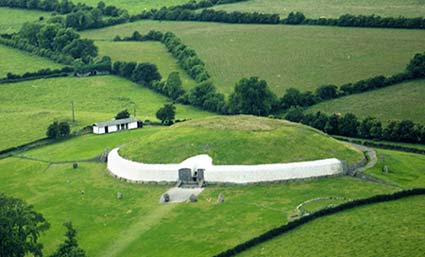
The tomb’s white quartz facade, constructed after excavation in the late 1960s, is its most dramatic exterior feature.
What they found is now understood as Ireland’s most significant archaeological treasure, a World Heritage Site3 that predates Egypt’s Great Pyramid by more than 500 years and is a thousand years older than Stonehenge in England. Newgrange, constructed c. 3200 BCE, is one of the oldest surviving buildings in the world.
In the virtual-reality tour (above) you will be able to explore Newgrange from ten different positions, beginning inside the tomb and continuing outside with exterior views and a perspective from atop the mound.
Serendipitously, the discovery of Newgrange occurred just as the polymath Keeper of the Ashmolean Museum at Oxford, Edward Lhwyd, was traveling through Ireland. Lhwyd asked to be taken to New Grange and was given a tour of the newly discovered tomb. He wrote four letters documenting his experience, the first of which may be seen in its entirety by clicking on the image, below right.
“They came at last to a broad flat Stone, rudely Carved, and placed edgewise at the Bottom of the Mount. This they discover’d to be the Door of a Cave, which had a long Entry leading into it. At the first entering we were forced to creep; but still as we went on the Pillars on each side of us were higher and higher; and coming into the Cave we found it about 20 Foot high. In this Cave, on each hand of us, was a Cell or Apartment, and an other went on straight forward opposite to the Entry. In those on each hand was a very broad shallow Bason of Stone, situated at the Edge.” 4
Correctly deducing from the Roman coins (see illustration in gallery) found buried near the top of the mound that the later Viking invaders could not have constructed it, Lhwyd concluded, “it was some Place of Sacrifice or Burial of the ancient Irish.” He thus credited the indigenous people with this remarkable construction, although some later commentators would credit anyone except the Irish.5 But an earnest conjecture of his may have enabled much speculation and archeo-histrionics:
“We observed that Water dropped into the right-hand Bason, tho’ it had rained but little in many Days; and suspected that the lower Bason was intended to preserve the superfluous Liquor of the Upper (whether this Water were Sacred, or whether it was for Blood in Sacrifice), that none might come to the Ground.” 6

The first account of Newgrange, December, 1699, by Edward Lhwyd. (Philosophical Transactions (1683-1775) 27 (1710-1712): 503-05.)
In another letter Lhwyd speaks ominously of “a vulgar legend about some strange operation at that town in the time of heathenisme…”7
Lhwyd, a careful observer, unwittingly set in motion the imaginations of generations of antiquarians and others who used the mound for their own flights of fancy regarding human sacrifice. In a similarly lurid vein, Sir Thomas Molyneux in 1725 published an account in which he describes how
“When first the cave was opened, the bones of two dead bodies entire, not burnt, were found upon the floor, in likelihood the reliques of a husband and his wife, whose conjugal affection had joyn’d them in their grave…”
8
How did Molyneux see intact skeletons where the very meticulous Edward Lhwyd saw only scattered bones? It may be that the darkness of a mysterious tunnel can play tricks on the eyes—or the imagination. Thomas Pownall in 1773 concluded that the engravings on the Newgrange stones were really Phoenician characters, and thus the stones must have originally been used by the seafaring Phoenicians for their own monuments at the mouth of the Boyne, and only later assembled at New Grange.9 In 1786 Charles Vallancey studied the engravings on the Newgrange stones and translated them to obtain proof that the monument was a “Mithratic cave,” with its name derived from the Chaldean “Grian Uaigh, the “Cave of the Sun.”10
“…the Druids offered sacrifice; or at least, where they held their solemn meetings; for of its origin there is no doubt, and almost; as little, that it was the ‘Inner Temple’ of their secret rites.” 11
Mythology and Folklore
In their 1841 travel journal the Halls enthusiastically proclaimed Newgrange the spot where
“…the Druids offered sacrifice; or at least, where they held their solemn meetings; for of its origin there is no doubt, and almost; as little, that it was the ‘Inner Temple’ of their secret rites.” 11
But the local farmers who guided the Halls and other early visitors to the tomb had their own legends of the gods who inhabited the site, gods far older than those of the Druids.12 In local tradition, Newgrange was the home of Aengus Óg and the Daghdha, the gods of the Tuatha Dé Danaan.13 The ancient name for Newgrange and the other nearby tombs, including Knowth and Dowth, was Brú na Bóinne, the Palace of the Boyne. From the top of any one of these three major passage tombs, the other two may be seen. In the VR tour (top left) the telephoto view from the top of Newgrange will allow you to see Knowth, and a hotspot will virtually transport you to the top of the Dowth mound.
Around 1830 a priest went to Newgrange to try to uncover evidence of its ancient name still being used. He found that local usage referred to the site as “Bro-Park,” and nearby were “Bro-Farm” and “Bro-Mill,” all using the modern derivation of the older Irish Brú. “Thus, the identical name An Brugh, (the Palace) by which the celebrated place is called in the Senchus-na-Relec (History of Cemeteries), though unobserved by the learned, still lingers around the monument of the Danaans.”14
Professor Michael J. O’Kelly, who led the 1962-1975 excavation and reconstruction of the monument, was inspired by these legendary stories of the Palace of the Boyne. The gods and heros, while found in the Medieval manuscripts, likely date from earlier oral tradition. Professor O’Kelly, in fact, takes the oft-repeated claim that “the earliest Irish stories are a window on the Iron Age”15 and revises it:
“One cannot help feeling that the richly accoutered warriors of the Irish Bronze Age are far more convincing prototypes for the dramatis personae of the Irish heroic cycle than the shadowy figures [of the Iron Age]. If this were the case it would bring [the stories] nearer in time to the people who built the Boyne tombs. Can it have been they who planted the first seeds of Irish oral literature and should one begin to think of this not as a window on the Iron Age but as one on the Late Neolithic?” 16
The legendary resident of Brú na Bóinne, Aengus Óg, was the son of the Dagda, the “good god,” of the Irish.17
The Dagda had an affair with Aengus’ mother, Boann, who symbolized the river Boyne. To disguise the illicit union the Dagda ordered the sun to stand still for nine months. Thus Aengus was conceived, brought to term, and born all in one day.18 Aengus Óg, “Aengus the Young,” was also known as “Mac-an-Og,” the son of youth.19 He is similar to the Greek Eros, the god of youth and love.20
According to the twelfth-century Book of Lecan, when he learned that he would inherit nothing from his father the Dagda, Aengus used his wiles to re-order time in his own way. He asked the Dagda if he could live in Brú na Bóinne for “a day and a night,” and his father agreed. Afterwards, however, Aengus insisted that “a day and a night” was equal to “all days and all nights.” Thus he took over possession of the Palace on the Boyne.21
In another tale, Aengus fell in love with a girl named Caer Ibormeith whom he saw in a dream. Both his mother and his father searched Ireland for a year, but failed to find her. When finally Aengus found Caer, she was chained up with 150 other girls at the Lake of the Dragon’s Mouth. He discovered that on every other Samhain (November 1) all the girls would turn into swans for one year. Aengus was told he could have Caer if he could identify her as a swan.22
“‘Who is calling me?’ said Caer. ‘Angus calls you,’ he said, ‘and if you come, I swear by my word, I will not hinder you from going into the loch again.’ ‘I will come,’ she said. So she came to him, and he laid his two hands on her, and then, to hold to his word, he took the shape of a swan on himself, and they went into the loch together, and they went around it three times. And then they spread their wings and rose up from the loch, and went in that shape till they were at Brugh na Boinne. And as they were going, the music they made was so sweet that all the people that heard it fell asleep for three days and three nights.” 23
The epic significance of Brú na Bóinne was woven into the later tales of the Ulster Cycle. As Lady Gregory tells the story, the great Cúchulainn was conceived in the mound of Newgrange when his father Lugh of the Long Hand magically transported his mother Dectire there:
“And he put on them the appearance of a flock of birds, and they went with him southward till they came to Brugh na Boinne, the dwelling-place of the Sidhe. And no one at Emain Macha could get tale or tidings of them, or know where they had gone, or what had happened to them.” 24
The Palace on the Boyne also plays a role in the Fenian Cycle, the tales of Fionn Mac Cumhaill and his band of warriors. In the story called “The Pursuit of Diarmuid and Grainne,” after Diarmuid was gored by a boar and left by Fionn Mac Cumhaill to die in agony, his lover Grainne found his body watched over by Aengus Óg, along with three hundred of his followers.
“Oengus said: ‘[There has never been] one night since I took you with me to the Brugh over the Boyn , at the age of nine months, until tonight that I was not watching you and guarding you against your enemies, Diarmuid, and alas for the treachery that Fionn has done to you.’ He continued: ‘Horsemen of the fairy-mound without defilement, let Diarmuid of the fine shape be lifted by you to the Brugh, sweet, full of hosts, everlasting.'” 25
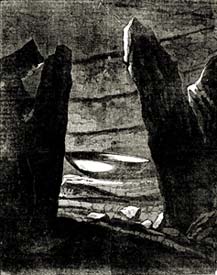
“East Recess of the Sepulchral Tumulus at New Grange” (“New Grange.” The Dublin Penny Journal 1.39 (1833): 305. “Drawing by Mr. Nicholl, of Belfast.”)
The early sanctity of Brú na Bóinne was invoked to enhance the legitimacy of those who were supposedly the later historical pagan kings of Ireland. In legend, the kings of Tara were originally buried in the royal cemetery at Rathcroghan (Crúachan) in Co. Roscommon. But when one of the kings married a woman from the Tuatha Dé Danaan, he and his descendants insisted on burial at the Palace of the Boyne.26
Cormac mac Airt was the most celebrated of the pagan High Kings of Ireland. In legend reared by a she-wolf in Co. Sligo’s Caves of Kesh, he grew to be, according to some, an actual historical ruler of the Ui Neil in perhaps the third century CE. According to the story, after he became aware of Christianity he vowed that he would not be buried with his predecessors at Brú na Bóinne, as it was the “chief cemetery of the idolaters,” and instead wished to be interred across the river at Ros na Righ.27
There may even be a connection between the Aengus Óg of Brú na Bóinne and the Aengus who gave his name to the spectacular Iron Age fort of Dun Aengus on the Aran Islands. Although in most accounts Dun Aengus was named after Aengus, King of the Clann Umoir, of the Fir Bolg, some think that this Aengus and Aengus Óg, son of the Dagda, are but two aspects of a single god, a Celtic Zeus.28
The Monument Under Siege
“Curiosity or avarice has excited many persons at different periods to examine into the interior parts of those repositories of the dead; the former in hopes of recovering from the oblivion of the grave something at least which might give an insight into the manners and customs of former times…the other, instigated only by the sordid hope of plunder.”
Thomas Pownall, “Description of the Sepulchral Monument at New Grange,” 177029
Pownall, an early antiquarian visitor to Newgrange, went on to express his concerns about the future of such monuments, threatened not only by those with “hopes of plunder” but also by more mundane circumstances, such as their use as stone quarries. There were parts of the Newgrange complex lost long before its modern archaeological excavation began in the 1960s.
When the entrance to Newgrange was first discovered in 1699, it is likely that much that would have been of interest to future archaeologists was swept aside in the quest for the “plunder” usually associated with these “caves.” The modern excavations uncovered evidence of funerary deposits haphazardly mixed into the earth of the tomb’s floor.30
Other potentially significant features of the monument seem to have disappeared since they were first reported, perhaps broken up, or perhaps still intact and serving unheralded as a supporting stone in a nearby domestic structure or in a field fence a few miles away. Some early visitors reported a prominent standing stone visible at the top of the mound, above its entrance (see illustration in gallery below).31 Major Vallancey reported seeing in 1776 a triangular-shaped stone just outside the entrance to the tomb. While other visitors did not note this stone, an archaeologist wrote in 1993 ” a re-examination of Professor O’Kelly’s excavation results indicates the probable position of the socket for this missing stone.”32
A 1797 report described how the stone basin in one of the tomb’s interior recesses came to be broken into pieces:
“…a Connaught peasant having dreamt that there was a treasure hidden beneath it, came here expressly to search it out; he was aided by others of the area as credulous as himself and equally as persuaded of the veracity of nocturnal visions; they removed all the stones forming the [pavement], they broke one of the basins and carried one that was in the centre to a corner and set it on one of those in the angles, and not having found anything, they left the stones all disarranged.” 33
In perhaps the most egregious case, a smaller passage tomb (“Site Z”) adjacent to Newgrange was completely destroyed, as an early 1820s account relates:
“Mr Kirk, the present occupier has lately blasted with powder some of these stones that stood in the way of his ploughing and in digging to remove the parts of each that remained in the ground there were found a number of long flags placed on their edges, between every two of which there lay a human skeleton the bones of which, the workmen say, were of a remarkably large size.”34
Other stones removed from the monument were used to create an early-nineteenth century “garden folly,” with two circular windows, just to the rear of the mound.35 Many visitors carved their names or initials deeply into the portal stones of the interior. Others, even those engaged in an earnest effort to advance the knowledge of the tomb, were to cause damage to the structure. In 1874 Richard Burchett had a notion that the decorated “lintel stone” over the Newgrange entrance could conceal another passage into the tomb. He then set upon an effort to remove the stone to allow him to enter the supposed secondary passage:
“I uncovered its whole surface, but found two men with crow-bars incapable of moving it without greater risk to its safety than I was willing to incur. Its mystery therefore remains unsolved.” 36
Such depredations for the most part ceased when finally all the monuments of Brú na Bóinne came under the protection of the state in 1882.37
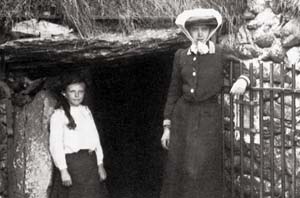
Mother and Daughter at Newgrange, c. 1910 (OPW).
Click on the book cover (left) to view R.A.S.Macalister’s 1929 Newgrange guidebook.
Download a PDF of the guidebook here (OPW).
Excavation and Reconstruction
Early state efforts to investigate and preserve the monuments were often haphazard and poorly documented. When he began his own Newgrange excavations in 1962 Professor O’Kelly was forced to proceed without the missing records from the nineteenth-century Office of Public Works modifications.38 Thus began the first comprehensive scientific investigation of the tomb, which would consume 13 years of work by the archaeologist and his colleagues, students, and workers from National University of Ireland (NUI) Cork and the Irish Tourist Board. There would be a further seven years until the publication of the research in 1982. This epic archaeological project was ultimately to result in the preservation and the modern reconstruction of the monument, most evident in the brilliant white entrance facade that greets its many thousands of yearly visitors.
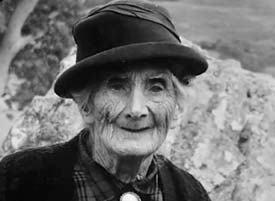
In this 1962 RTE interview with Professor Michael O’Kelly, ninety-year-old Anne Hickey recounts local superstitions (at 1:50). The same Mrs Hickey, leading a visitor into the passage tomb by candlelight, is mentioned in a 1914 book, in a 1950 newspaper story, and on a postcard.
When the investigations were completed and every stone put back into place, what resulted was a flat-topped heart-shaped mound some 11 m (36 ft) high and about 91.5 m (300 ft) in diameter, covering an area of nearly .4 ha (one acre). The base of the mound is held in place by 97 large kerbstones placed end-to-end horizontally. The mound itself was built from hand-sized rounded boulders, along with layers of sod for stability. The passage into the tomb (see diagram, below right), together with the corbelled-ceiling inner chamber, is 24 m (79 ft) long, penetrating only a third of the way into the mound. It was constructed, entirely without mortar, of large slabs, some up to 2 m (6.5 ft) tall. Many of these slabs were sumptuously decorated with spirals, concentric semi-circles, and lozenges (diamond-shapes). Similar decorations are to be found on many of the kerbstones.
At the end of the passage the large cruciform central chamber, with its high ceiling, opens into three smaller recesses, each of which held a large “basin stone,” which may have held the burnt bones of the dead. The “Great Circle” of 12 boulder-like standing stones, up to 2.5 m (8 ft) high, partially surrounds the monument. There may once have been a complete circle of some 35 to 38 stones. This feature was built more than a thousand years after the passage tomb itself, which was built in the Neolithic period, around 3200 BCE.
Excavation trenches into the adjacent landscape uncovered evidence of a smaller (destroyed) passage tomb, a later ritual monument known as a “woodhenge,” and a ceremonial pathway or “cursus.” There is evidence that the surrounding area may have once contained up to forty tombs.39 As archaeologist Michael Herity put it,
“Probably the most dynamic and accomplished people to settle in Ireland during the whole span of prehistory were the builders of the passage graves. In energy and creativity they are rivaled only by the Celts. Their spectacular tombs, the massive tumuli with which they are covered, and the carvings on the tomb walls are their best-known achievements; these are all the more remarkable when we consider that they were erected in the Stone Age…” 40
Today’s monument with the brilliant white entrance facade was not the Newgrange that Professor O’Kelly saw as he began his work in 1962. An earlier generation of archaeologists had already uncovered the circle of kerbstones, previously buried in the slip of the cairn materials over the millennia (see photo in gallery).41 But the entire mound was covered in scrub brush, and “improving” nineteenth-century landowners had planted trees on its top, the roots of which were piercing down to damage the integrity of the covering stones. The fact is, some visitors to the pre-excavation monument had become attached to its wild and romantic appearance and voiced their concern that the monument as seen today is too “modern looking.” Professor O’Kelly answered that:
“Newgrange must have been ‘modern looking’ also to the Boyne valley people…when it was first built. Then the white quartz wall stood as it is now, and above its top the mound surface was one of naked stones – there were no trees, no scrub, no weeds nor grass.
…
It has been understandably difficult for those who knew Newgrange in the romantic days of candlelight to accept the fact that, when originally built, the mound was drum-like rather than dome-shaped.” 42
Before the tomb could be reconstructed in its modern form, the archaeologists had to remove much of the covering cairn and the roofing stones of the passage in order to create a concrete dome protecting the chamber. Other stones were braced and stabilized in position. The heaviest stone removed, using a crane, weighed more than 9,000 kg (ten tons). Although most were lighter, Professor O’Kelly wondered how the Neolithic-era builders could lift such stones. As an experiment he had some of his men, experienced in the handling of large stones, move a 900 kg (one-ton) stone using only rollers on a ramp. With a length of rope, three men were able to move it a distance of 15 m (49 ft) and 4 m (13 ft) in elevation during twelve hours of labor.43
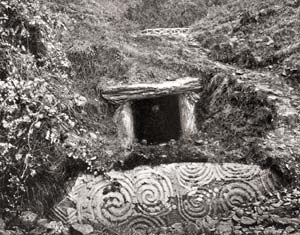
In this c. 1880 photograph by R. Welch, the decorated edge of the roof-box lintel is seen above the entrance.
The excavation of the monument yielded numerous finds from the area outside its kerb, including almost 1,000 flint artifacts and 274 pottery objects. Other finds were of stone, bone, glass, and metal, such as the Roman coins mentioned above. None of these objects, however, could be attributed to the actual builders of the monument.44 But within the tomb there were some items that escaped the attentions of earlier generations of treasure-seekers. A large hammer-shaped pendant was found in the center of the main chamber; nearby were a serpentine marble and some flint flakes. In the west recess a pendant and pieces of bone tools were found mixed with the burnt human bones remains. The east recess was the largest, and was extravagantly decorated on its roof (see diagram in gallery, and move the point of view upward in the virtual-reality environment). Recovered from that recess were a bone chisel, marbles, beads, and a pendant.45
Human remains, some found mixed into the earth on the floor of the tomb where they were discarded by the eighteenth-century visitors, represented at least five different persons, although there may have been many more. Three of the individuals were cremated; the other two were unburnt.
“However many or few were contained in these tombs they must surely have been special in some way. The number of workers and their families who built Newgrange must have been considerable and yet they were not buried in or immediately around it. We have no way of knowing in what way the people who were put inside Newgrange were special; it does not necessarily follow that they were royal or priestly, they may have been special in some quite different way.” 46
Were these individuals, whatever their claim to prehistoric notoriety, all interred at Newgrange at one time? Was the closing slab, now bolted to the side of the entrance, then dragged into place, sealing the tomb from visitors until it was uncovered at the end of the seventeenth century?47 An astonishing discovery made by Professor O’Kelly may have provided the answer and allowed him to become the first person in five millennia to witness a ceremonial event programmed by the tomb’s builders.
The Roof-Box
What was then known as the “false lintel” was first described by William Wilde after his 1847 visit (see photograph, above left). Wilde’s sketch of the inscribed pattern on this stone is in the gallery below. Dr. Wilde noted that it was discovered a “few years ago:”
“…the edge of another very curious, and most exquisitely carved stone, was found projecting from the mound, a short distance above and within the line of the present entrance… This stone, of which we can only perceive the edge, is five feet eight inches long; its sculpture, both in design and execution, far exceeds any of the rude carvings which are figured, apparently at random, upon the stones found within the cave; and as it never could have been intended to be concealed from view, it is most probable that it decorates the entrance into some other chamber, which further examination may yet disclose.”48
When Professor O’Kelly first removed the stone and earth off of the large horizontal slab below this “very curious” stone noted by Dr. Wilde, he was the first to expose the previously-unknown “roof-box” of which Wilde’s “most exquisitely carved stone,” was actually the covering stone.49 The archaeologist found a box-like structure, open at the front of the tomb, with another carved stone at its other end. The width of the roof-box forms a slit, or aperture, into the tomb, which was found shuttered by two blocks of quartz. Scratch marks on the supporting stone indicated that the quartz blocks had been removed and reinserted a number of items; similar marks on the surviving block of quartz served to confirm this.50
After repeatedly hearing a local tradition that told how the sunrise used to light up the triple-spiral stone at the end recess far within the tomb, Professor O’Kelly wondered if the roof-box aperture was intended to admit the light of the rising sun. The Winter Solstice sunrise, due to Newgrange’s southeast orientation, seemed to be the best candidate for this possibility. As an experiment, he positioned himself inside the tomb in the hour before the sun was to rise on the 21st of December in 1967. He repeated the experiment two years later and tape-recorded his observations:
“At exactly 8.54 hours GMT the top edge of the ball of the sun appeared above the local horizon and at 8.58 hours, the first pencil of direct sunlight shone through the roof-box and along the passage to reach across the tomb chamber floor as far as the front edge of the basin stone in the end recess. As the thin line of light widened to a 17 cm-band and swung across the chamber floor, the tomb was dramatically illuminated and various details of the side and end recesses could be clearly seen in the light reflected from the floor. At 9.09 hours, the 17 cm-band of light began to narrow again and at exactly 9.15 hours, the direct beam was cut off from the tomb. For 17 minutes, therefore, at sunrise on the shortest day of the year, direct sunlight can enter Newgrange, not through the doorway, but through the specially contrived slit that lies under the roof-box at the outer end of the passage roof.” 51
According to archaeologist Carleton Jones, we cannot be certain that the priests of the Neolithic culture that created Newgrange would have been inside the tomb to witness the phenomenon. However it seems likely that a select few may have been, while the majority of the community would have shared the experience vicariously from the outside. They would have watched as the officiates climbed up to the roof-box to remove the quartz blocking the aperture.52
It is impossible to know which, if any, members of the Neolithic community were allowed inside Newgrange to observe the sunrise of the Winter Solstice. Today, however, we always know by late September who the fortunate few will be, as a lottery draw determines who gets the privilege of viewing the phenomenon from inside the tomb. The event has come to symbolize a national appreciation for this monument of the distant past, with such significance that the video of the solstice is broadcast live and streamed on the Internet (see archive above, right) and major political figures are eager to be present for the sunrise at the tomb. What began 5,000 years ago as a spiritual celebration has now become a community ritual of a different sort. In 2011 there were 31,531 entries for the Newgrange drawing, but only 10 winning couples are allowed to enter the tomb each day during a five-day period when the sunrise effect is visible. Click here for information on entering the Newgrange Solstice Lottery, which takes place in late September. Photographs of the solstice sunrises may be seen here.
The White Quartz Facade
Quartz played another role in the construction—and the reconstruction—of the monument, one that was perhaps more significant, and ultimately more controversial, as well. As Professor O’Kelly excavated the area around the perimeter of the tomb he was careful to note the stratigraphy—where different materials occurred at different depths. He found at the front of the tomb a layer almost entirely composed of angular pieces of white quartz.53 Since these white quartz pieces were not found underneath any of the fallen kerbstones, the archaeologist concluded that the quartz fell off the front of the monument, perhaps in a single rapid event, after the collapse of the kebstones and the release of the weight of the mound behind them.54
It was this discovery that caused Professor O’Kelly to revise the planned reconstruction of the monument with a sloping face. Instead he devised a plan to embed the collected white quartz stones in the concrete of a vertical wall at the front of the tomb, centered about the entrance (seen in the first two virtual-reality views). His decision, and the visual effect that was its outcome, was controversial at the time and continues to evoke passionate discussion among those who are concerned about the monument and the accurate portrayal of prehistory. Called a “Disney-fication” by some,55 French archaeologist P. -R. Griot described it as “sort of cream cheese cake with dried currents distributed about…56
Others, such an the excavator of nearby Knowth, George Eogan, maintain that the vertical wall of quartz could not have been constructed without concrete, a technique unavailable to the tomb’s original architects. When Professor Eogan discovered a similar quartz layer at Knowth, he allowed the pieces to remain as found, a layer of white carpeting on the ground.57 Many archaeologists, however, such as Carleton Jones, feel that Professor O’Kelly’s stratigraphy study “makes a compelling case for the acceptance of this reconstruction…58
“Quartz is certainly a visually striking stone—it sparkles, it is luminous…It is not surprising, therefore, that prehistoric people attached a special significance to it…[the white quartz at Newgrange] would have glowed in the light of the morning sun and so we might suggest that there was some connection between quartz and the sun. On the other hand, the whiteness of quartz resembles most closely the whiteness of that other great heavenly body—the moon…Some researchers have suggested that because quartz comes from the ground but catches the light from the sky, it may have been regarded by prehistoric people as important because it mediated between the realms of earth and sky. Others have suggested the luminous quality of quartz might have symbolized the life force or perhaps even the human ‘soul.'” 59
While it is difficult to comprehend the meaning of the Winter Solstice to the Neolithic mind, it may be even more problematic to interpret the intricate carvings, the prehistoric artwork that decorates some 110 of the monument’s uncovered exterior and interior slabs.
Perhaps the most celebrated of these stone carvings is the triple-spiral that decorates the right-hand side slab of the rear (north) recess of the inner chamber. This may be seen in a close-up view within the virtual-reality environment; view it in full-screen mode to note all the detail of the engraved stone. This iconic “triskele,” illuminated only once a year by the sun of the Neolithic Winter Solstice, may have symbolized for the builders a connection between different realms of existence, a vortex enabled by the sunlight.60 The Newgrange art consists of a variety of curvilinear and rectilinear motifs,61 which are found on both the visible and the hidden surfaces of the stones.
The Newgrange entrance stone, also featuring a triple spiral, is considered to be “one of the most impressive combinations of art and architecture.”62 It may be viewed in an interactive graphic, top left. The art on this stone was created in situ, while the Neolithic artisans decorated the other stones before they were put into place. According to Dr. Jones, the Neolithic community may have seen this massive stone as a threshold separating the world outside from the spiritual space inside the tomb, with the designs communicating to those on the outside what they would find within, and the straight line that unwinds from the spirals near the top of the stone indicating the entrance to the other world inside the tomb.
When archaeologist George Coffey investigated the monument in 1892, he came away convinced that the carvings were purely decorative, and saw their significance as marking the “beginning of decorative art and architecture in Ireland.”63 Professor O’Kelly came to believe that it was the physical act of creating the carvings that was most important, “fulfilling a ceremonial or spiritual or symbolic purpose.”64 However some of the earlier visitors to the monument showed no reluctance to pronounce far more specific interpretations for the megalithic art. Pownall and Vallancey saw actual alphabets and attempted to read specific meanings into the inscriptions. (See Vallancey’s illustrations, below left.65) Some modern visitors have derived their own inspirations from the Newgrange rock art.
“Many attempts have been made to interpret passage tomb art. There are some who say that the art looks like a series of maps of the area, maps of the stars, or maps of the afterworld. Some see the art as a meditation device or argue that it represents images induced by hallucinogens. Others argue that it is music. The most popular theory is that the forms represent the changing seasons, the passage tomb builders’ preoccupation with time and with marking major solar events like the solstices and the equinoxes. Perhaps the changing and cyclical nature of the seasons was bound in the people’s minds with their own lives. Perhaps from their observations of the natural world they hoped that just as winter was followed by spring, new life followed death.”
Clare Tuffy, OPW66
Ancient and Modern Spirituality
“I shall not unnecessarily trespass upon the time and patience of my readers, in endeavouring to ascertain what tribes first peopled this country; nor to what nation the construction of this singular monument may reasonably be attributed; for, I fear, both its authors and its original destination, will ever remain unknown. Conjecture may wonder over its wild and spacious domains, but will never bring home with it either truth or conviction.”
Sir Richard Colt Hoare, Journal of a Tour in Ireland, A.D 180667
The Neolithic peoples who occupied the rich fertile lands of the Boyne Valley created a community stable and cohesive enough to build structures destined to last more than 5,000 years. Powerful rulers, perhaps priest-kings, inspired the loyalty required for these achievements because they were believed to communicate with their ancestors in another plane of existence. To envision just how many members of the community may have been required to build Newgrange, Professor O’Kelly calculated that the 181,436,948 kg (200,000 tons) of earth and rock required would have taken a workforce of 400 people 16 years to carry to the spot and construct the mound.68
It was clear to the excavator and others that all this effort was not solely to create a house of the dead. Newgrange was also seen as a residence of other-dimensional beings, a home of the spirits. The great care taken by the Neolithic builders, which included cutting rain channels on some of the roof stones to keep the interior dry, shows a respect for the structure that was remembered through all the succeeding generations. Respect came even from the invading Vikings of the ninth century, who never entered the tomb, and to those visitors who left golden coins in tribute. No such tribute was found elsewhere at the other nearby passage tombs.
“The three great Boyne tombs must have been sources of awe, wonder and superstition from very early times, perhaps even from their very beginning; indeed the arousal of these emotions may have played no small part in the minds of their builders in the first place. Perhaps the tombs were built as much to commemorate and arouse respect for the gods or spirits as to provide resting places for the newly dead.” 69
The veneration of Newgrange continued long after the liturgy of its builders was forever lost, even after the tomb had begun to collapse onto its kerbstones, and its entrance sealed by tons of rock and earth. In the late Neolithic and early Bronze Age, a thousand years after the construction of the Brú na Bóinne tombs, the new Beaker culture farmers of the Boyne built their own settlement, squatting right up against the side of Newgrange. It may have been these people who built the incomplete circle of stones around the monument.70 They also built, just 9 m (30 ft) away from the tomb, a large circular enclosure of timbers posts. In the center of this circle archaeologists discovered pits where small animals were cremated and buried. The OPW illustration of this “woodhenge” ceremonial center may be seen in the gallery below. Nearby is the “cursus,” the surviving 100 m (328 ft) of the route of a ritual procession through the landscape.
Our understanding of the geographical extent, and the complexity, of the Brú na Bóinne complex is still developing. In 2018 an extraordinarily dry summer allowed previously unknown subterranean features to be discovered by drone photography. A preliminary report of these features may be read here.
“The vista must have been very impressive, indicating that by the Late Neolithic religious ceremonies and processions were taking place across the landscape of Brú na Bóinne, with their organisers using the river valley to create their own theatre of ritual.” 71
Such scenarios as these, imagined by archaeologists and anthropologists from clues left in the earth and observations of indigenous peoples, can never completely explain the belief systems of the ancient peoples of the Boyne Valley. In their desire to commune with the remote civilization that built and worshipped at Newgrange, some have today projected their own sincerely held spirituality onto the monument. Just as Vallencey and others saw Phoenician letterforms in the Brú na Bóinne spirals, there are authors today who combine their observations with their intuition to arrive at conclusions quite outside the realm of archaeology. Some have suggested that specific constellations, guide points for ancient astronomers, can be deciphered in the ornamented stones of Newgrange.72 One book, with information derived from “the ancient tradition of Freemasonry…rediscovered among the Dead Sea Scrolls,” postulates that Newgrange, “a large house built of crystals,” was actually a ” a machine for the reconstruction of a shattered world.”73 More soberly, Martin Brennan’s work in The Boyne Valley Vision and The Stones of Time has gained a wide following:
“The ancient mounds in the Boyne Valley are a great feat of non-verbal communication. Their message comes to us through four millennia of time. By using universal and concrete symbols like the sun and the earth itself, this message transcends the barriers of language. These mounds are concrete realizations of the world view of ancient man in Ireland. In this great vision, the whole cosmos is symbolized.” 74
We cannot know how the excavator of Newgrange might have responded to those seekers of the sacred who made their pilgrimages to Brú na Bóinne following its reconstruction. Professor O’Kelly, sadly, did not live to see the 1982 publication of the book documenting his work. But the academic archaeologist and the devotee of sacred sites may have more in common than is immediately evident. Carleton Jones, of NUI Galway, explains that for the Neolithic people “points in the landscape marked by the Boyne monuments were viewed as supernaturally powerful…”75 Dr. Jones suggests that the builders of Brú na Bóinne may have chosen the spots for their monuments in order to enhance the existing “power points” they perceived on the landscape. In their Powerful Places in Ireland guidebook, authors Elyn Aviva and Gary White write that Newgrange “continues to be a powerful place, drawing thousands of visitors throughout the year who bring a mixture of curiosity, awe, and reverence.”76
Irish author, poet, and self-described clairvoyant Æ (George William Russell) wrote of the inspiration for his dialogue at Brú na Bóinne with Aengus Óg (excerpted at the top of this page) in which “a light began to glow and to pervade the cave…”
Russell wrote those words 70 years before Professor O’Kelly became the first person in 5,000 years to see the light of the Winter Solstice enter the passage of Newgrange.
“…one warm summer day lying idly on the [Newgrange] hillside, not then thinking of anything but the sunlight, and how sweet it was to drowse there, when, suddenly, I felt a fiery heart throb, and knew it was personal and intimate, and started with every sense dilated and intent, and turned inwards, and I heard first a music as of bells going away, away into that wondrous underland whither, as legend relates, the Danaan gods withdrew; and then the heart of the hills was opened to me, and I knew there was no hill for those who were there, and they were unconscious of the ponderous mountain piled above the palaces of light, and the winds were sparkling and diamond clear, yet full of colour as an opal, as they glittered through the valley, and I knew the Golden Age was all about me, and it was we who had been blind to it but that it had never passed away from the world.” 77
Click here to see all the notes from this page.
Newgrange Passage Tomb, Co. Meath
Nearest Town: Drogheda
Townland: Newgrange
Latitude: 53° 41′ 38.90″ N
Longitude: 6° 28′ 29.78″ W
Note: Access to Newgrange is only by guided tour from the Brú na Bóinne Visitors Centre, which is here.
External Links:
Visitors’ Center
Private tours of the Boyne monuments
Ireland’s World Heritage Sites
Images of Newgrange Through the Ages

